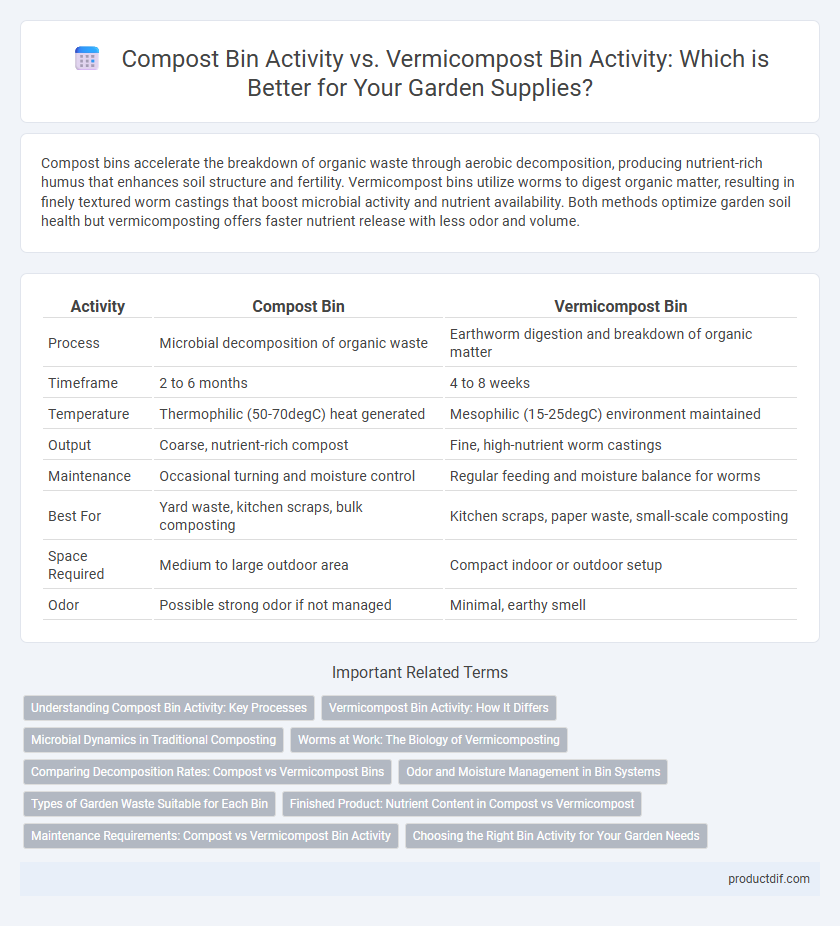Compost bins accelerate the breakdown of organic waste through aerobic decomposition, producing nutrient-rich humus that enhances soil structure and fertility. Vermicompost bins utilize worms to digest organic matter, resulting in finely textured worm castings that boost microbial activity and nutrient availability. Both methods optimize garden soil health but vermicomposting offers faster nutrient release with less odor and volume.
Table of Comparison
| Activity | Compost Bin | Vermicompost Bin |
|---|---|---|
| Process | Microbial decomposition of organic waste | Earthworm digestion and breakdown of organic matter |
| Timeframe | 2 to 6 months | 4 to 8 weeks |
| Temperature | Thermophilic (50-70degC) heat generated | Mesophilic (15-25degC) environment maintained |
| Output | Coarse, nutrient-rich compost | Fine, high-nutrient worm castings |
| Maintenance | Occasional turning and moisture control | Regular feeding and moisture balance for worms |
| Best For | Yard waste, kitchen scraps, bulk composting | Kitchen scraps, paper waste, small-scale composting |
| Space Required | Medium to large outdoor area | Compact indoor or outdoor setup |
| Odor | Possible strong odor if not managed | Minimal, earthy smell |
Understanding Compost Bin Activity: Key Processes
Compost bin activity involves aerobic decomposition of organic waste by microorganisms, producing nutrient-rich humus essential for soil health. Vermicompost bin activity relies on earthworms to break down organic matter, accelerating decomposition and enhancing microbial diversity. Understanding these key processes helps gardeners optimize nutrient cycling and improve soil fertility for sustainable plant growth.
Vermicompost Bin Activity: How It Differs
Vermicompost bin activity differs significantly from traditional compost bin activity by relying on earthworms to break down organic waste, accelerating decomposition and enriching the compost with nutrient-dense worm castings. This process maintains a cooler temperature and requires more moisture control compared to the aerobic, heat-driven breakdown in regular compost bins. Vermicomposting produces finer, more biologically active humus, making it highly beneficial for enhancing soil fertility in garden supplies.
Microbial Dynamics in Traditional Composting
Traditional composting in a compost bin fosters diverse microbial dynamics by promoting thermophilic bacteria and fungi that efficiently break down organic matter at elevated temperatures. In contrast, vermicompost bins support mesophilic microbes driven by earthworm activity, enhancing nitrogen fixation and nutrient mineralization under cooler conditions. The microbial succession in traditional bins accelerates organic decomposition, while vermicomposting emphasizes microbial populations beneficial for soil health and plant growth.
Worms at Work: The Biology of Vermicomposting
Worms play a crucial role in vermicompost bin activity by breaking down organic matter more rapidly and producing nutrient-rich castings that enhance soil fertility. Unlike traditional compost bins that rely on microbial decomposition and higher temperatures, vermicomposting leverages the digestive processes of earthworms, especially red wigglers, to accelerate organic waste transformation. The biology of vermicomposting reveals that worm gut enzymes and microbial interactions optimize nutrient cycling, making vermicompost bins highly efficient for garden supply enthusiasts seeking sustainable soil amendments.
Comparing Decomposition Rates: Compost vs Vermicompost Bins
Vermicompost bins typically exhibit faster decomposition rates than traditional compost bins due to the efficient breakdown of organic material by earthworms and microbes. Compost bins rely mainly on microbial activity and require higher temperatures and longer timeframes, often weeks to months, to achieve full decomposition. Studies show vermicomposting can reduce organic waste volume by up to 50% within 2-4 weeks, outperforming conventional compost bins which may take 6-12 weeks under optimal conditions.
Odor and Moisture Management in Bin Systems
Compost bins rely on aerobic decomposition, requiring regular turning to manage odor and maintain optimal moisture levels, while vermicompost bins utilize worms that naturally aerate the system and consume organic matter, reducing ammonia buildup and unpleasant smells. Moisture control in vermicompost bins is critical to worm health, as excessive dampness can lead to anaerobic conditions and odor, whereas compost bins demand consistent moisture to support microbial activity without causing sogginess. Proper ventilation in both systems is essential to prevent foul odors and ensure efficient biodegradation of garden waste.
Types of Garden Waste Suitable for Each Bin
Compost bins effectively process a wide range of garden waste, including dry leaves, branches, grass clippings, and vegetable scraps, breaking them down through aerobic decomposition. Vermicompost bins specifically handle organic kitchen waste, fruit peels, coffee grounds, and soft garden residues, utilizing earthworms to accelerate nutrient-rich humus production. Avoid placing meats, dairy, or oily materials in either bin type to prevent odors and pests.
Finished Product: Nutrient Content in Compost vs Vermicompost
Compost bins typically produce finished compost rich in macronutrients like nitrogen, phosphorus, and potassium, essential for general soil health enhancement. Vermicompost bins yield vermicompost with higher microbial activity, enriched with beneficial microorganisms and bioavailable nutrients that promote plant growth and improve soil structure. The nutrient content in vermicompost is often more concentrated and biologically active compared to traditional compost, making it highly effective for nutrient uptake in garden plants.
Maintenance Requirements: Compost vs Vermicompost Bin Activity
Compost bins require regular turning and moisture monitoring to maintain aerobic conditions and optimize decomposition, while vermicompost bins demand consistent temperature control and careful feeding to support worm health and activity. Compost bins can handle a wider range of organic materials but may take longer to process, whereas vermicompost bins need balanced inputs of nitrogen-rich food scraps and bedding to prevent odors and promote efficient worm digestion. Maintenance of vermicompost bins involves managing worm population density and harvesting nutrient-rich castings, which requires more attentive care compared to the less frequent but labor-intensive upkeep of traditional compost bins.
Choosing the Right Bin Activity for Your Garden Needs
Compost bins efficiently break down kitchen scraps and garden waste through aerobic decomposition, producing nutrient-rich humus ideal for large-scale garden beds. Vermicompost bins utilize red worms to convert organic waste into high-quality worm castings, enhancing soil structure and promoting plant growth in smaller or indoor gardens. Selecting the right bin depends on your garden size, available space, and desired nutrient output, ensuring optimal composting activity tailored to your garden's needs.
Compost bin activity vs Vermicompost bin activity Infographic

 productdif.com
productdif.com